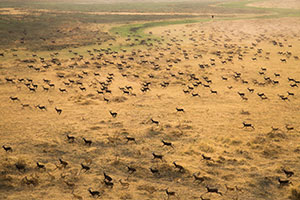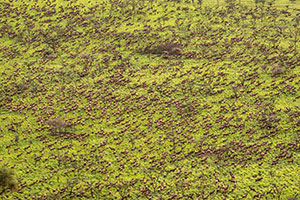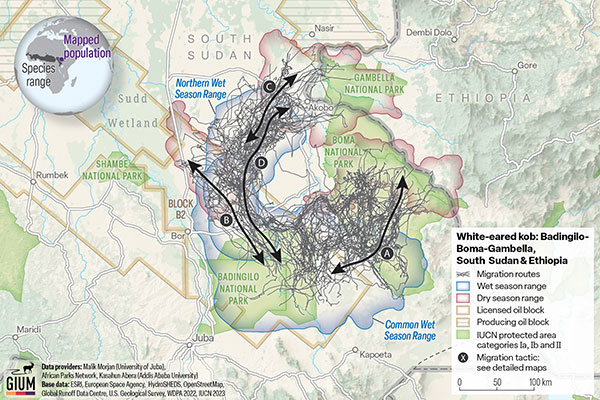
New maps released this week document the world’s largest land mammal migration, revealing the seasonal journeys of more than 5 million white-eared kob and tiang antelope across South Sudan and Ethiopia.
The work was made possible by the Global Initiative on Ungulate Migration (GIUM), a partnership of international researchers headquartered at the University of Wyoming that is producing detailed maps to guide conservation and infrastructure planning to protect ungulate migrations worldwide.
The maps were informed by animal tracking data collected by African Parks and the Ethiopian Wildlife Conservation Authority. They depict, in unprecedented detail, the expansive “Great Nile Migration,” one of the last remaining large-scale land migrations on Earth.
All told, biologists estimate the migrations include approximately 5 million to 7 million animals across four species -- white-eared kob, tiang, Mongalla gazelle and Bohor reedbuck.
Wildlife experts across Ethiopia and South Sudan contributed their knowledge and expertise to the effort. A key contributor was Professor Malik Morjan, of the University of Juba in South Sudan, who provided critical data and expertise.
Morjan emphasizes the national and global significance of the migration.
“We are dedicated to conserving and studying the migrations here in South Sudan, which are not only globally significant, but also part of our national identity,” Morjan says.
GIUM operates under the auspices of the Convention on the Conservation of Migratory Species of Wild Animals (CMS) and aims to document, study and conserve major ungulate migrations worldwide. Its signature effort, the online Atlas of Ungulate Migration, provides a global resource for conservationists, planners and policymakers.

“The Great Nile Migration is one of Earth’s most extraordinary wildlife spectacles, even larger in numbers and spatial extent than the wildebeest migration of the Serengeti,” says Matthew Kauffman, a leading science adviser to GIUM and a professor of wildlife biology at the U.S. Geological Survey’s Wyoming Cooperative Fish and Wildlife Research Unit based at UW.
“This work builds on the now-established conservation framework of mapping and analyzing migrations based on fine-scale GPS data,” Kauffman says. “By making these movements visible, these maps will better inform conservation and development planning at a critical time.”
The new maps also highlight growing pressures from development, including oil exploration in South Sudan’s “Block B2,” and underscore the urgent need for informed planning to safeguard migratory routes and wildlife populations. Similar to migration mapping in Wyoming, these new maps can help wildlife managers balance the needs of wide-ranging animals with industrial development.
A key aspect of the newly released migration maps is their availability through the Atlas of Ungulate Migration. The cartography, infographics and web operability for the atlas were created by cartographers at the University of Oregon InfoGraphics Lab, with web programming by Gage Cartographics.
The atlas provides detailed maps, fact sheets and spatial data so that stakeholders in the region can incorporate the information into ongoing conservation planning and sustainable infrastructure development. This approach -- using detailed maps to guide conservation and development -- has proven to be an effective means to advance conservation of ungulate migrations around the world.
Migration maps and related resources are available through the Atlas of Ungulate Migration at www.cms.int/gium.



